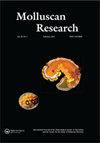韩国南部海岸日本铁的分子鉴定
IF 0.6
4区 生物学
Q3 ZOOLOGY
引用次数: 0
摘要
摘要本研究首次对来自韩国的日本铁藻标本进行了分子分析,重点对COI和H3基因区域进行了物种鉴定和系统发育分析。共从韩国南海岸的三个不同地点采集了13个样本,其序列已在NCBI GenBank中登记。COI和H3基因区域被成功扩增并双向测序,为未来的DNA条形码研究提供了有价值的参考。基于COI和H3序列的系统发育分析表明,韩国和日本的J.ferrea种群缺乏明确的区域分化。尽管在区分铁藻的区域特征方面存在局限性,但该研究证实了COI和H3基因对准确物种鉴定的适用性。这些发现强调了使用多种分子标记进行全面DNA分析的重要性,以提高物种识别的准确性并最大限度地减少错误识别。需要进一步的研究,包括扩大采样和额外的DNA区域,以阐明铁藻的系统发育关系和分布。本文章由计算机程序翻译,如有差异,请以英文原文为准。
Molecular identification of Japeuthria ferrea from the south coast of Korea
ABSTRACT This study represents the first molecular analysis of Japeuthria ferrea specimens from Korea, focusing on COI and H3 gene regions for species identification and phylogenetic analysis. A total of 13 samples was collected from three different locations along the south coast of Korea, and their sequences were registered in the NCBI GenBank. The COI and H3 gene regions were successfully amplified and bidirectionally sequenced, providing a valuable reference for future DNA barcoding studies. Phylogenetic analysis based on both COI and H3 sequences demonstrated that the Korean and Japanese J. ferrea populations lacked clear regional differentiation. Despite the limitations in differentiating the regional characteristics of J. ferrea, the study confirms the applicability of COI and H3 genes for accurate species identification. The findings emphasise the importance of employing multiple molecular markers for comprehensive DNA analysis to improve species identification accuracy and to minimise misidentification. Further investigation involving expanded sampling and additional DNA regions is required to elucidate the phylogenetic relationships and distribution of J. ferrea.
求助全文
通过发布文献求助,成功后即可免费获取论文全文。
去求助
来源期刊

Molluscan Research
生物-动物学
CiteScore
1.80
自引率
10.00%
发文量
27
审稿时长
>12 weeks
期刊介绍:
Molluscan Research is an international journal for the publication of authoritative papers and review articles on all aspects of molluscan research, including biology, systematics, morphology, physiology, ecology, conservation, biogeography, genetics, molecular biology and palaeontology.
While the scope of the journal is worldwide, there is emphasis on studies relating to Australasia and the Indo-west Pacific, including East and South East Asia. The journal’s scope includes revisionary papers, monographs, reviews, theoretical papers and briefer communications. Monographic studies of up to 73 printed pages may also be considered.
The journal has been published since 1957 (as the Journal of the Malacological Society of Australia until 1993). It is free to members of the Malacological Society of Australasia and the Society for the Study of Molluscan Diversity.
 求助内容:
求助内容: 应助结果提醒方式:
应助结果提醒方式:


